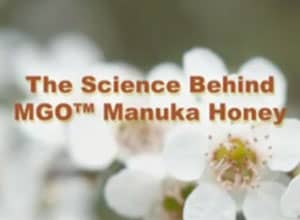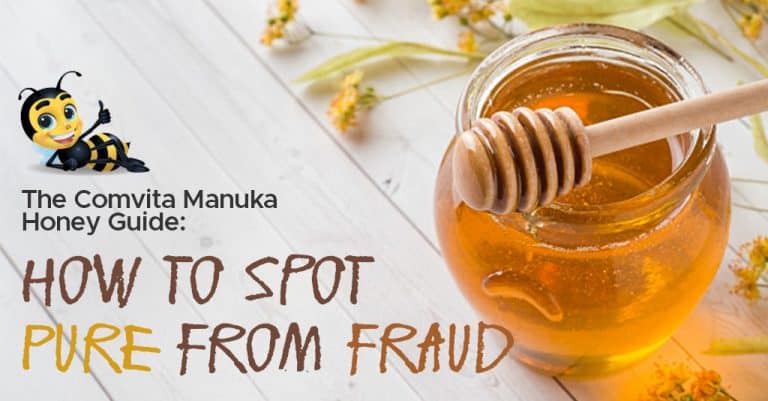What Does UMF® Mean for Manuka Honey?
What Does UMF® Mean for Manuka Honey?
It’s velvety, luscious, and beneficial, but what do you really know about the UMF label on your favourite manuka honey?
It’s normal to be confused about those labels on the different manuka honey brands available in the market. Fear not – we’re here to clear your conceptions and confusion!
Stay with us till the end to get an insightful understanding of the common UMF, MGO, MG and NPA labels.
Manuka Honey UMF® by the New Zealand Government
90% of “manuka honey” sold worldwide are fake.
Sometimes it’s just regular honey, other times it’s even worse: nothing more than sugar syrup with chemicals added. The New Zealand government was aghast at the damage done to the branding of real manuka honey.
Therefore, the government founded the UMF Manuka Honey Board to officially label and monitor honey farms in New Zealand that meet the standard of real manuka honey.
Most supermarkets, retailers, and even distributors do not even know that the manuka honey they sold is fake. Hence, they tend to consciously promote their “sales” or “trusted” manuka honey to unsuspecting customers.
They may cite that UMF labels are too expensive for real manuka honey, but that is false as the New Zealand government insists on UMF labels now.
Be cautious for your family and your health. Buy only UMF-endorsed manuka honey.
What Is Manuka Honey?
For thousands of years, honey has been known for its special properties. Certain honey from specific plants have a greater range of attributes than others, and the honey that comes from some varieties of the New Zealand Manuka bush (Leptospermum scoparium) is one of these.

Manuka honey is a form of mono-floral honey produced by bees that collect nectar from the flowers of the manuka bush or tea tree (also known as Leptospermum Scoparium).
This bush is indigenous only to New Zealand and a tiny zone off Australia. Manuka bushes thrive at this specific climate zone and also the rich dark soil of New Zealand.
Worker bees then add an enzyme, glucose oxidase, to the nectar inside the hive, in order to preserve the honey for storage and use later.
When manuka honey is eaten, the glucose oxidase enzyme will slowly release anti-bacterial hydrogen peroxide. The levels of hydrogen peroxide released is sufficient to destroy bacteria but safe enough to not affect any of our human tissues.
Studies on manuka honey’s benefits have shown that manuka honey, a special type of mono-floral honey, contains an ingredient with powerful anti-bacterial, anti-microbial, anti-viral, antioxidant, antiseptic, anti-inflammatory and anti-fungal properties. This ingredient was originally named UMF®.
What Is UMF® in Manuka Honey?

Peter Molan, an associate professor in biochemistry from the University of Waikato in Hamilton, New Zealand, is one of the pioneer scientists to research the benefits of manuka honey.
In 1981, he discovered that some samples of manuka honey contained a non-peroxide component and started to tinker with research on manuka honey’s properties and benefits for consumption.
Warning: Do NOT confuse active manuka honey UMF 20+ or MGO 400+ (any numbers) with Active Manuka Honey 20+ (any number). If the honey is not labeled with UMF or MGO, you are buying only table honey.
Tests conducted proved that after adding a catalase to the samples of manuka honey to remove the hydrogen peroxide, some samples still had significant anti-bacterial activity. Dr. Molan named this non-peroxide element UMF®, or Unique Manuka Factor.
He proved that not all manuka honey has UMF® and that not all levels of UMF® have anti-bacterial, anti-viral or antiseptic benefits. The higher the UMF® level, the higher the health benefits.
Dr. Molan’s research proved that manuka honey’s benefits makes it the most powerful bacteria killer even when diluted 10 times. He recommends manuka honey especially for people with weak immune systems.

Laboratory tests found the UMF® property to be effective against a wide variety of bacteria including Helicobacter Pylori (known to cause most stomach ulcers), Staphylococcus Aureus (Staph), Escherichia Coli (the most common cause of MRSA and other infected wounds) and Streptococcus P.
There are a number of essays and techniques including newly emerging work that determines what manuka. They will be available to the consumer to verify the origin and provenance of this distinctive product. The UMF® rating is a measure of the attributes and values that make up Manuka honey, and assures purity and quality.

The UMF grading system appraises natural markers found in manuka honey. This is compliant with the recent interim labelling guidelines published by the Ministry for Primary Industries (MPI).
The UMF grading system has two components used on any UMF-licenced honey product:
- The label that claims it’s manuka honey
- The number – it represents 3 chemical markers that indicate the content of this honey to ensure purity and quality. This includes the key chemical markers DHA and MGO.
To receive a UMF® grading, honey must have the presence of DHA (dihydroxyacetone), Methylglyoxal, and Leptosperin.
| Methylglyoxal Level (MGO Level) | UMF® Grade |
| ≥83 mg/kg | 5+ |
| ≥263 mg/kg | 10+ |
| ≥514 mg/kg | 15+ |
| ≥573 mg/kg | 16+ |
| ≥696 mg/kg | 18+ |
| ≥829 mg/kg | 20+ |
| ≥1200 mg/kg | 25+ |
| ≥1449 mg/kg | 28+ |
Why Is Manuka Honey or Manuka Oil So Expensive?
Manuka oil and manuka honey comes from honey that is mono- floral. This refers to a type of honey that has a distinctive flavour or other attribute as a result of being predominantly from the nectar of one plant species.
Compared to poly-floral honey, which bees can harvest from many different flowering species, mono-floral honey is more difficult to ensure. Manuka oil or honey must be from bees working on the manuka bush.
Manuka bushes are only found in New Zealand, and a small tiny zone of Australia. It requires a specific climate and the soil found in the New Zealand and the zone of Australia to grow well. As you can tell, the supply is limited to only these plantations in New Zealand.
In recent years, lab tests and reports have discussed and promoted the benefits of manuka honey, and the general public is now aware of the health benefits. As such, demands have skyrocketed and huge demands along with limited supplies made manuka honey and manuka oil much more expensive than normal table honey and oil.
What Is the Difference Between UMF and MGO/MG and Other Manuka Honey Standards?
UMF is the official standard by New Zealand Government while MGO and MG are standards created by major manuka honey brands.
UMF is a grading scheme endorsed by the New Zealand government. It’s considered the gold standard for ensuring authentic manuka honey with the correct minimum methylglyoxal level for each grade.
UMF for manuka honey is the best standard you can trust. Every batch is laboratory tested to prove it has the correct level of methylglyoxal for its grade of UMF 5+, 10+, 15+ and etc.
Technically, UMF refers to the level of methylglyoxal, and methylglyoxal is further broken down to MGO. Some enterprising manuka honey businesses took the MGO labeling to become a rating system of their own.
MGO – A Ranking Referring Directly to Methylglyoxal in Manuka Honey

MGO is the second tier; they are owned privately by companies that want to give customers a form of trusted authenticity. MG is similar and ranked a close third in terms of recognition. Though not as solid and a gold standard as UMF, they can still be trusted as these private companies do their best to protect the rating.
There are various misuse cases of the label NPA, too. NPA refers to the non-peroxide activity in manuka honey; the higher, the better.
Convert UMF to MGO, MG, or NPA for Manuka Honey
If you’re unsure of the similar levels for UMF to MGO and NPA, you can use this table to convert between manuka honey’s UMF, MGO, and NPA ratings.

This Table Provides a More Specific Number Level for Converting Manuka Honey UMF to MGO and NPA
| UMF RATING | MINIMUM MGO* METHYLGLYOXAL | MINIMUM NPA** NON-PEROXIDE ACTIVITY |
|---|---|---|
| UMF 20+ | 829 | 20.0 |
| UMF 18+ | 692 | 18.0 |
| UMF 15+ | 550 | 15.6 |
| UMF 15+ | 514 | 15.0 |
| UMF 12+ | 400 | 12.9 |
| UMF 12+ | 354 | 12.0 |
| UMF 10+ | 263 | 10.0 |
| UMF 5+ | 100 | 5.6 |
| UMF 5+ | 83 | 5.0 |
| – | 30 | 2.7 |
* MGO is measured as mg/kg (ppm)
** NPA is measured as % solution (%w/v) of phenol/water
Do note that UMF manuka honey bought from a reputed retailer means it is lab-tested and certified to be manuka honey. MGO, MG, and NPA have less authenticity compared to UMF, hence their pricing tends to be lower. Only buy these products after you have done your research. If not, stick to UMF brands.
If you come across other manuka honey rating that is not UMF, MGO or MG, please be cautious. There are numerous private ratings that are not endorsed, and may not even have scientific lab tests to prove the methylglyoxal level in the manuka honey. Various fly-by-night rankings are created and not well proved.
Should I Trust UMF, MGO, or MG for Manuka Honey Authenticity?
UMF is officially endorsed and undergoes consistent and regular laboratory testing. It’s the gold standard for manuka honey.
UMF Is the Trusted Standard for Manuka Honey, Followed by MGO and MG
Buy Only Manuka Honey With These UMF Logos

There are many fakes and imitation brandings like MG, Active Rating, and even fake “UMF” logos that are not the official New Zealand government’s endorsed UMF scheme. Please be cautious and buy only reputable brands from reputable and experienced sellers.
Manuka HoneyCity Singapore has been selling New Zealand UMF manuka honey as well as New Zealand artisan honey.
They are shipped directly from New Zealand to our local warehouse in Singapore. We are proud of our designated specialty store and have been shipping parcels of UMF honey worldwide since 2014. Check out the range of UMF manuka honey that we carry!
[vc_row][vc_column]












